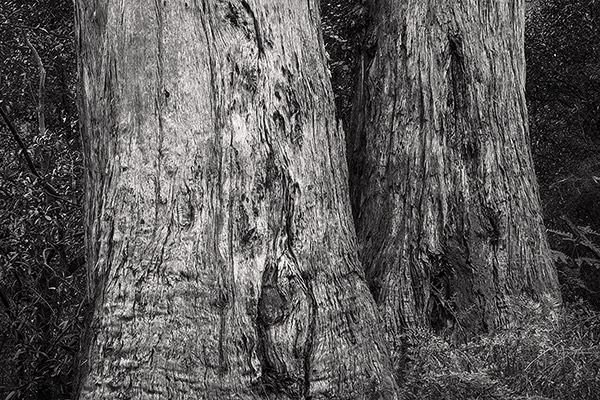The Elders, Eucalyptus Regnans, Victoria, Australia
(Click image to enlarge)
Reaching heights of more than 114 meters (375 feet), mountain ash trees (eucalyptus regnans) are the second tallest trees on earth and the world's tallest flowering plant. The trees in this photograph began growing before the rest of the world knew Australia existed. Across the centuries they have survived countless storms, and unlike 99% of their relatives they have avoided humans with saws.
Historically, fires have not occurred often in this wet rainforest environment, but that is no longer true. Human caused climate change is creating more severe droughts more frequently, and today fire is a significant threat to these tall mountain ash forests. These trees are very sensitive to fire, and nearly all that are burnt are killed. Essential oils that give eucalyptus trees their fragrance are highly flammable. They also produce large quantities of flammable material in the leaf litter layer on the forest floor. This makes it easy for a fire to get started and spread quickly. In addition the outer layer of bark on eucalyptus trees dies each year and peels away. Countless long strands, some of which are many meters long, hang from the tree trunks, and fall onto other foliage and the forest floor. These quickly take fire high up into the canopy and form burning embers that can be cast 30 kilometers (18 miles) ahead of a fire. Fires in Australia have been measured traveling up to 72 km/h (45 mph). Eucalyptus trees have some ability to re-sprout after a fire and their seeds often survive, but today's more frequent and intense fires limit the ability of these forests to regenerate.
Although these tall mountain ash forests can dominate a landscape for many hundreds of years, they are not the final stage of natural succession. In fact they are self extinguishing because mountain ash seedlings cannot survive in the shade created by a mature mountain ash forest. The final stage of natural succession in these regions is the myrtle beech forest. These shade tolerant trees take over as the mountain ash trees age and eventually die off. With a very low fire resistance and low tolerance for full sunlight, myrtle beech forests are often completely wiped out by fires, and the fire - mountain ash - myrtle beech cycle repeats.
Having eliminated roughly 99% of these native forests, logging has historically been far more damaging to these forests than fire. Fortunately a landmark supreme court judgment in November of 2022 found that the state-owned logging agency, VicForests, has broken the law by failing to protect endangered species. Accordingly, all logging of Victoria's native forests stopped in December of 2023. Since Australia's mountain ash forests have the highest biomass carbon density of any forest on earth, this court decision is beneficial for both our climate and the forests, not to mention the diverse species of plants and animals that these forests protect.
